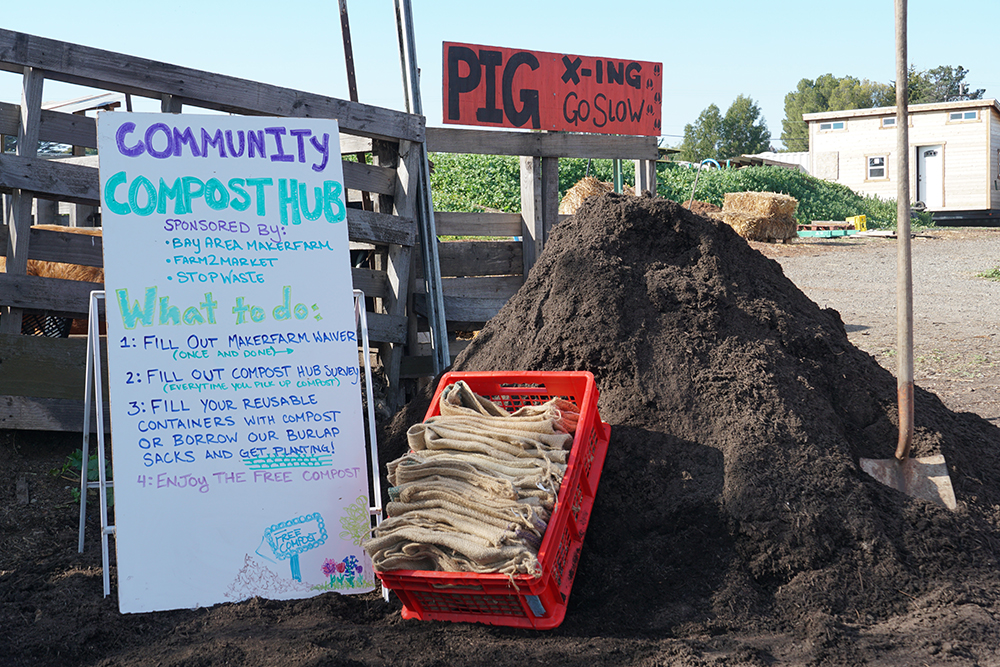Alameda Sun – Tuesday, February 8, 2022
by Alison Limoges, Board member of Alameda Backyard Growers and Master Gardener
 As humans, we all eat. Some of us grow our own food, but mostly we buy, prepare food, and then dispose of the leftovers. Unless we have pigs or goats to consume our scraps the best-case scenario is that we convert the scraps, and yard trimmings, into fresh compost for our houseplants or home gardens. This way we nourish our bodies, put carbon back into our soil, and inexpensively feed our plantings. Many residents of Alameda (and the other cities in Alameda County) have been sorting food and yard trimmings into green bins for years, but much of the rest of the state has not. This led to the passage of SB 1383m to get everyone diverting food and yard trimmings from gray bins/landfill into green bins for conversion into compost.
As humans, we all eat. Some of us grow our own food, but mostly we buy, prepare food, and then dispose of the leftovers. Unless we have pigs or goats to consume our scraps the best-case scenario is that we convert the scraps, and yard trimmings, into fresh compost for our houseplants or home gardens. This way we nourish our bodies, put carbon back into our soil, and inexpensively feed our plantings. Many residents of Alameda (and the other cities in Alameda County) have been sorting food and yard trimmings into green bins for years, but much of the rest of the state has not. This led to the passage of SB 1383m to get everyone diverting food and yard trimmings from gray bins/landfill into green bins for conversion into compost.
(California SB 1383 is a bill that sets goals to reduce disposal of organic waste in landfills, including edible food. The bill’s purpose is to reduce greenhouse gas emissions, such as methane, and address food insecurity in California. Aspects of this law ensure that food scraps are composted and compost is purchased by cities.)
By using the green bins, we are helping to feed ourselves because most of the compost created is used by farms in the Central Valley that grow the food we eat. Although Alameda County residents have been putting compostables into green bins for a long time, we can still do better. And now SB 1383, as of January 2022, requires the rest of the state to do the same and to help make treated compost more available for use by California residents.
By taking compostables out of landfills, SB 1383 will help reduce the emissions of short-lived climate pollutants (SLCPs) which affect human health and contribute to climate change. In addition, cities across California are required to procure compost and then decide where to use it. Locally, Farm2Market and Bay Area Makerfarm at Alameda Point are collaborating with StopWaste to pilot the first six months of a new project that will model a compost hub off of NorCal Resilience Network’s Resilience Hubs to distribute compost to Alameda residents. The City of Alameda is working with StopWaste and has agreed to consider distributing compost from the hub as it learns more. Giving away compost to residents will save the city the cost of spreading some of the compost on city land.
What does all of this mean to Alamedans? Soon, with a slow rollout, the Compost Hub will be accessible from both Farm2Market (its entrance at 2600 Barbers Point Road) and from Makerfarm (an additional entrance on Main Street and Singleton Avenue). The compost will be available for pickup by individuals, and residents will need to sign a waiver and complete a brief survey collecting information that will encourage cities like Alameda to distribute compost to residents.
So, for those of us not making our own compost it’s even more important that we use our green bins regularly and appropriately. If we want to have clean compost in Alameda, it’s required that we keep glass, plastic, animal feces, and other non-compostables out of the green bins. In that way we’ll be doing our part to help complete the cycle of using food waste to feed our soil and reduce carbon dioxide and other pollutants in our atmosphere. Once Alameda’s Compost Hub is officially up and running the process will benefit us all and it will be an important model for other cities and counties in California to replicate.
Go to www.stopwaste.org/rules to learn how SB 1383 will help us all put a substantial amount of carbon back into our soil by generating and using more compost, thus helping to reduce climate change in our own backyards!
Alameda Backyard Growers is planning a free — online and in-person — start-to-finish Compost 2.0 training for teens through seniors in which attendees will make and take home their own compost. Sign up to our mailing list or keep checking our website to learn more as details become available.
